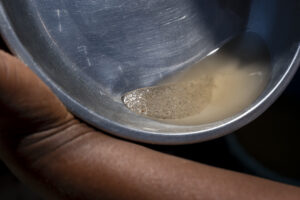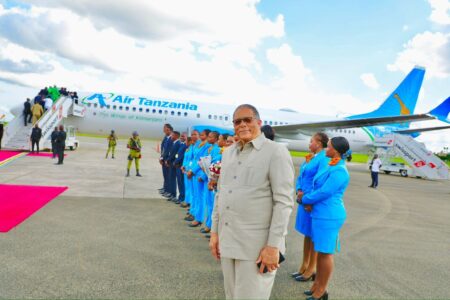- Statistics show that the spread of mpox continues to worsen in Africa with over 2,500 new cases recorded in the last week alone.
- Epicentres the DRC and Burundi account for 86.7% of all new confirmed cases reported during the past week.
- To counter the disease spread, partners are supplying vaccines to nine hard-hit countries.
Mpox outbreak is reportedly worsening in Africa as the number of cases crossed 50,000 mark, the Africa Centers for Disease Control and Prevention (Africa CDC) has warned.
The threat was announced at a media brief on Thursday by Africa CDC Director-General Jean Kaseya, who highlighted that 19 African countries have reported 50,840 mpox cases, with 10,741 confirmed and 1,083 deaths since the start of this year.
“During last week alone, the continent reported 2,532 new cases, including 345 confirmed cases and 32 new deaths,” he reported.
According to the CDC Director-General, data from the African Union’s specialized healthcare agency indicate that the number of confirmed mpox cases in Africa has surged by over 545 per cent this year.
According to the African Union report, the Central Africa region is the worst hit by mpox outbreak, accounting for 85.8 per cent of all reported cases and 99.4 per cent of deaths so far.
“We are still in the acute phase of the outbreak and that is pushing us to redouble our efforts to control the mpox outbreak in Africa,” the CDC Director-General told media.
He also revealed that the Democratic Republic of the Congo (DRC) and Burundi account for 86.7 per cent of all new confirmed cases reported during the past week.
He expressed concern over the recent increase in mpox cases in Uganda as the country continues to record increase of confirmed cases and thus posing a threat to the rest of the East African countries.
He also confirmed that at least 14 African countries have active transmission of the mpox virus, but he also reported that four African countries, Cameroon, Gabon, Guinea, and South Africa, have not reported any new cases in the past six weeks.
“While some countries have not reported cases for consecutive weeks, they remain at risk due to cross-border transmission,” he cautioned.
He went on to point out that there is growing concern over the impact of comorbidity, which refers to a case where there is simultaneous presence of two or more diseases or medical conditions in a patient.
“With mpox, we see that mortality is closely associated with HIV, especially in cases where HIV is poorly managed and recently diagnosed,” he said.
“Comorbidity is playing a key role as we saw deaths in Uganda and Kenya recently, and also the two deaths we had in South Africa are linked to HIV. That is why we are promoting double testing of mpox and HIV,” he went on to explain.
Mpox outbreak in Africa
Mpox was first detected in laboratory monkeys in 1958 and is said to be a rare viral disease typically spread through body fluids, respiratory droplets, and other contaminated materials. When infected with mpox, the patient suffers from fever, rash, and swollen lymph nodes.
As of mid-August this years, the Africa CDC declared the mpox outbreak in Africa to be a public health emergency of continental security. The World Health Organization has also declared mpox a public health emergency of international concern and has activated its highest level of global alert for mpox.
The WHO has also declared outbreak of mpox, particularly the surge of the viral strain clade Ib, in the Democratic Republic of the Congo and neighbouring countries to be a public health emergency of continental security.
It said this year, 19 countries in Africa have reported new infections of the viral disease and that the epicentre of the outbreak remains to be the Democratic Republic of the Congo, where there are over 38 000 suspected cases and over 1000 deaths reported this year.
Read also: What WHO and Africa CDC seek to achieve with $600M Mpox outbreak response plan
Efforts to curb spread of mpox
The Access and Allocation Mechanism (AAM) for mpox has allocated an initial 899 000 vaccine doses for nine countries across the African region that are reported to be the worst hit by the ongoing mpox surge.
Authorities from AAM say they are working in collaboration with affected countries and donors to ensure that the limited doses are used effectively to control the outbreaks.
Organisations working to curb the spread of mpox include the Africa Centres for Disease Control and Prevention (Africa CDC), the Coalition for Epidemic Preparedness Innovations (CEPI), Gavi, the Vaccine Alliance (Gavi), UNICEF, and World Health Organization (WHO).
The ongoing allocation of vaccines follows recommendations of an independent Technical Review Committee of the Continental Incident Management Support Team for mpox based on country readiness and epidemiological data.
The nine countries to receive the vaccine are the Central African Republic, Cote d’Ivoire, the Democratic Republic of the Congo, Kenya, Liberia, Nigeria, Rwanda, South Africa and Uganda.
“The largest number of doses (85%) of the allocation will go to the Democratic Republic of the Congo as the most affected country, reporting four out of every five laboratory-confirmed cases in Africa this year,” reads the AAM report.
The report says vaccination is recommended as a part of a comprehensive mpox response strategy. The report also emphasizes timely testing and diagnosis, effective clinical care, infection prevention, and the engagement of affected communities.
“Vaccines play an important role and are recommended to reduce transmission and help contain outbreaks,” the report says.
The report goes on to explain that vaccination has begun in the Democratic Republic of the Congo and Rwanda and the said allocation to the nine countries marks “a significant step towards a coordinated and targeted deployment of vaccines to stop the mpox outbreaks.”
“For most countries, the rollout of mpox vaccines will be a new undertaking,” the report reads and cautions that the implementation of targeted vaccination requires additional resources and calls on partners of the mpox AAM to scale up the response.
AAM notes that over 5.85 million vaccine doses are expected to be available to the Mpox Vaccines AAM by the end of 2024 and this includes the 900 000 already allocated doses.
According to AAM, the vaccine supply includes contributions from multiple nations and organizations, including 1.85 million dose donations of MVA-BN from the European Union, United States, and Canada, 500 000 doses of MVA-BN from Gavi utilizing the First Response Fund, 500 000 doses procured through UNICEF, as well as a further 3 million doses of the LC16 vaccine from Japan.











